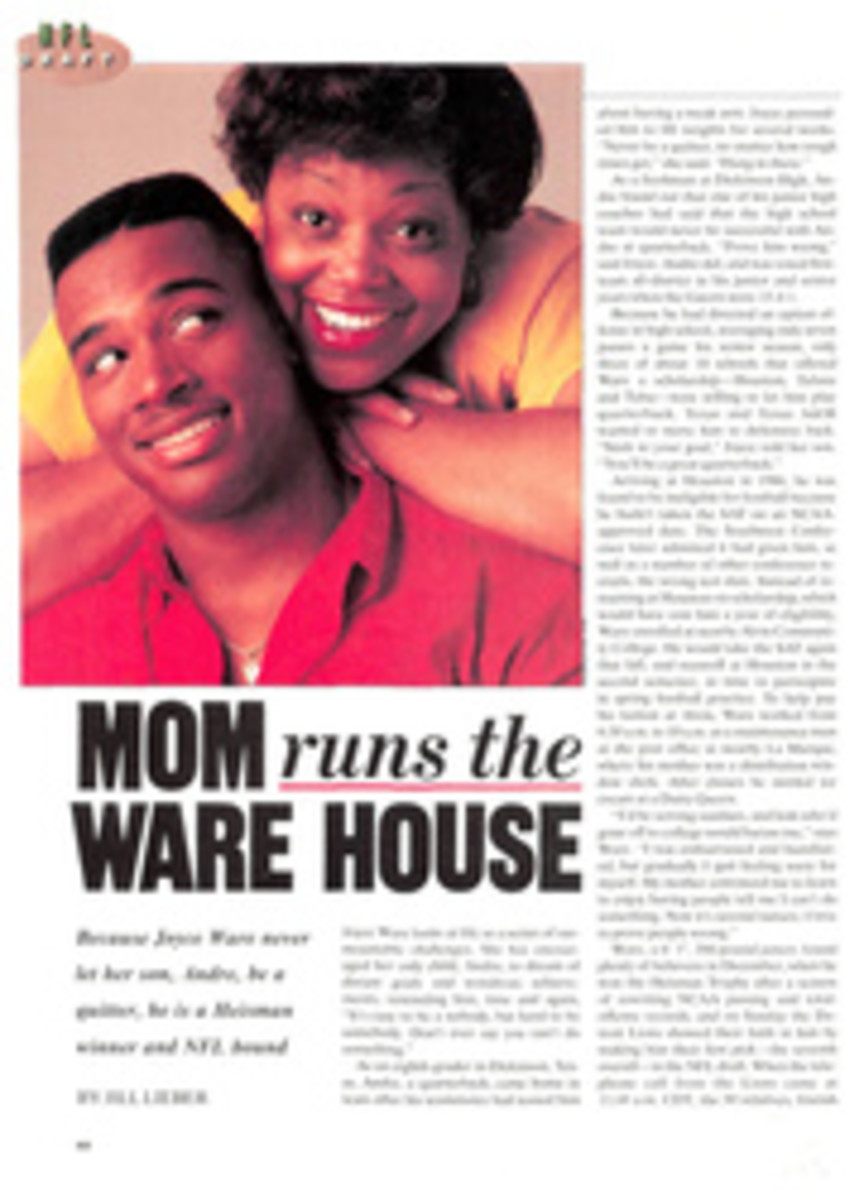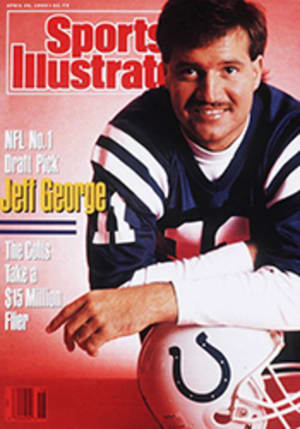
SAVE THE GOALIES
A goaltender's crease was once his castle. It was flanked by two four-foot-high, unyielding steel posts and fronted by two ill-humored defensemen whose primary responsibilities were to protect the goaltender from hindrance or harm and help him keep the puck out of the net.
Tending goal was simpler then. Defensemen rarely deserted the front of the net to join the attack. The posts, which were fitted over steel rods that were bolted into the concrete beneath the ice surface, did not budge upon contact. Those few daredevil scorers willing to risk injury by going all the way to the goal understood the consequences should the goalie be jostled or hurt. If the offending player was not gored by the goal or immediately pummeled by one of the goalie's vigilante teammates, his number would be noted, and it would be open season on him the next time the referee looked the other way. In the NHL, crashing into the goaltender used to be expensive. Now it might be the cheapest shot in the house.
This is particularly true during the playoffs. In the regular season's six months, an elbow occasionally finds a goaltender's throat, and the odd stick may slam across the back of his knee. Some teams go to the net with more determination than others. Some goalies, known to rattle more easily than others, are more frequently the object of physical abuse. Still, over 80 games, knocking goalies down is more often happenstance than strategy. But after the first week of April, when the goaltender becomes the most significant obstacle in the way of a team's advancing to another playoff round, he becomes prey. So, he had better pray.
In some of the more notable incidents since the playoffs began on April 4, three goalies have had to leave games after being run over. The Edmonton Oilers' Glenn Anderson, a notorious crease-crasher, may or may not have been tripped by Shawn Cronin of the Winnipeg Jets as he continued goalward after taking a shot in Game 4 of the Oiler-Jet Smythe Division semifinals. Nevertheless, avoidance was hardly on Anderson's mind when he turned Winnipeg goalie Bob Essensa into a 7-10 split. Essensa first caught Anderson's knee in his chest and then in his head and was knocked cold. He was finished for the night.
In Game 5 of the Toronto Maple Leafs-St. Louis Blues Norris Division semifinals, Leaf goalie Jeff Reese was helped from the ice after suffering a knee injury during what appeared to have been an inadvertent hit by the Blues' Dave Lowry. Only 27 seconds later, the St. Louis goalie, Curtis Joseph, was a victim of the Leafs' onrushing Dave Hannan. Hannan, going to the net for a rebound, hit the off-balance Joseph, who suffered a sprained shoulder. Backup goalie Vincent Riendeau had to complete the final 8:43 of the Blues' series-clinching 4-3 victory.
"We're going to have to address this over the summer," says Jim Gregory, who, as the NHL's vice-president of hockey operations, oversees the league's officiating staff. "The net is doing what it was designed to do, but now we have created another problem."
The net to which Gregory refers was introduced in 1984-85, when the NHL, citing safety concerns, replaced the steel-rod goal anchors with Megg-Nets, circular magnets embedded in the ice and protruding slightly above its surface. Each goalpost rests on a Megg-Net. The device, the invention of Dennis Meggs of Kitchener, Ont., is designed to let the cage break free when 200 pounds of pressure is applied to it. In practice, however, it may take only a little nudge from a besieged goalie or defenseman to knock the net loose and thereby gain a whistle and a breather. At least in terms of injuries caused by players colliding with the net, the Megg-Net has made hockey somewhat safer.
But "there's less fear involved in crashing the net than there used to be," says Boston Bruin goalie Andy Moog. "Coaches suggest to the players that they go to the net, and they come so hard that even if they want to stop, they can't. When I used to reach down and cover the puck, I would get soaked from the spray from the skates of guys stopping. I can't remember the last time that happened."
Instead, he gets the sort of treatment usually reserved for condemned buildings. The role of the steel ball is played by the onrushing forward. The role of the building is played by the goalie. He winds up crumpled in the corner of the dislodged net. Or under a 225-pound forward. Or looking into a doctor's penlight, trying to remember which city he's in. Of course, if the goalie isn't really hurt, it's good strategy for him to pretend that he is, so that the referee will call a penalty. Skating has always been an underrated skill for a goalie. Now, so is writhing.
Just because the goalie is encased in padding does not mean he is protected. At almost all times, he's watching the puck, which means that unless the shooter continues right at the goaltender after taking a shot, practically every hit the goalie takes comes from a blind side. And since he is barely moving or is standing stock-still, the goalie is no match for a 6'3" winger traveling at approximately 20 mph. "They do it to your goalie, and then you feel like you have to do it back to theirs," says Roger Neilson, the coach of the New York Rangers. "I don't like that part of the game at all."
The disease is becoming epidemic, and the NHL is faced with a manifest choice. Either it can read the goalie the last rites, or it can reinforce his rights.
According to the rule book, those rights are inalienable. Take 47(c): "A minor or major penalty shall be imposed on a player who charges (takes more than two strides at) a goalkeeper while the goalkeeper is within his goal crease."
And 62(c): "A minor penalty shall be imposed on a player who, by means of his stick or his body, interferes with or impedes the movements of the goalkeeper by actual physical contact, while he is in his goal crease area, unless the puck is already in that area."
And 62(d): "Unless the puck is in the goal crease area, a player of the attacking side may not stand...in the goal crease. A minor penalty shall be imposed on any player of the attacking team who deliberately stands in the goal crease area."
Unfortunately, the rules in the book are not uniformly enforced. The referee has a lot to watch. Philadelphia Flyer goalie Ron Hextall's solution to lax enforcement is a two-handed chop with his heavy goalie stick to a trespasser's leg. "Believe me, I take three times as much as I give," Hextall says. "People will take it whatever way they want, coming from me. But goalies who don't have my reputation are getting hacked off too. Whether you're Ron Hextall or the most mild-mannered player, if you get hit for the fifth time, you're going to get mad."
Boston goalie Reggie Lemelin did. At age 35, he's hardly an angry young man, but on March 10, sweet old Reggie reacted to being run over by the New York Islanders' Alan Kerr by spearing Kerr in his midsection. "Spur of the moment," says Lemelin, who received a five-minute spearing penalty and a game misconduct. "I'm not proud of it. But it was the third time in the game that it had happened, and I got mad. The Islanders do it [rush the goalie] more than any other NHL team.
"When I first came into the league, anybody who hit the goalie would have to pay the consequences. Somebody would go after him. Now it seems like there are no consequences. The guy who goes after the guy who hit the goalie winds up with all kinds of penalties. Now the goalie faces a power play, and he winds up the loser. We always wind up the loser."
Certainly Islander goalie Mark Fitzpatrick did by blowing his cool during Game 2 of the Patrick Division semifinals against the New York Rangers. Already steaming because he had given up three quick goals in a four-minute span in the second period, Fitzpatrick boiled over after being crashed by the Rangers' Troy Mallette. Referee Denis Morel had his arm up to penalize the Islanders' Bryan Trottier for hauling down Mallette, but Fitzpatrick butt-ended the Ranger winger while he lay on the ice. In addition to a game misconduct, Fitzpatrick received a five-minute penalty, which the Rangers converted into a goal that put their 5-2 victory away.
Fitzpatrick's temper does not serve him well. But considering how hockey is now played, his 6'2" body will. There has always been some prejudice against little goalies, because they cover less of the net-and seem to wear down faster than big net minders. There remain good small goalies in the NHL, but unless the league takes protective measures, the 5'9" goalie will become as rare as the 5'9" forward. Unless, of course, all the 6'2" goalies are pounded down five inches.
Unquestionably, the magnets are drawing more players than ever to the net, contributing to the problem. But the essential difficulty with today's NHL is the size of the players. While the players have gotten bigger and bigger, the ice surface hasn't. With no real mandate to widen the rinks an additional 15 feet to international size, NHL general managers this summer will study a number of other options, including new net supports and more consistent enforcement.
Moog says there's nothing wrong with the nets or the referees; it's the system that needs an overhaul. "Hockey has not changed its system of officiating since the goal judges were taken off the ice and put in the stands," he says. "That was more than 70 years ago. The fastest game in the world is still officiated by one referee, with the linesmen calling offsides, icings and just a few penalties.
"We need two referees to see everything. I don't buy the argument that two in the same game will apply different standards. We have different standards from different referees on different nights right now. The players adjust. We'd adjust to two refs too."
Rather than ask for a second referee, the general managers are likely to demand that the league more rigorously enforce the rules that protect goalies. Meanwhile, the ground rules for the 1990 playoffs are clearly established. At the end of May, the last goalie standing will get to carry the Stanley Cup. By then all the other goalies may have been carried off.
TWO PHOTOS
MIKE POWELL/ALLSPORT USA
Calgary's Mike Vernon was woozy (below) after L.A.'s Todd Elik tagged him in the Smythe semis.
PHOTO
BRIAN MILLER/BENNETT STUDIOS
Lemelin all but prayed when Yvon Corriveau took a flyer at him in the division semis.
PHOTO
DIANE SOBOLEWSKI
Moog's world came off its axes when the Whalers' Pat Verbeek got pushed into the net.
TWO PHOTOS
ANTHONY NESTE
A goal made when the net is off its Megg-Net (left) doesn't count; above, the Caps scored just such a nongoal on Ranger John Vanbiesbrouck.

